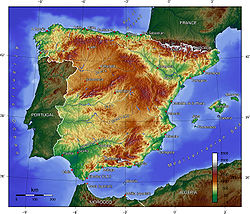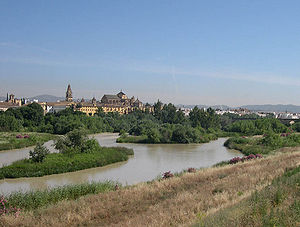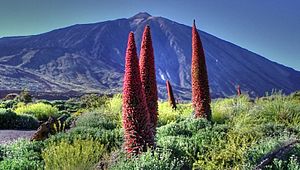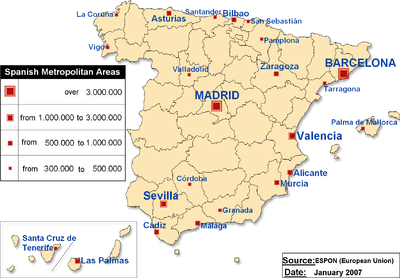- Geography of Spain
-
Geography of Spain 
Continent Europe Region Southern Europe
Iberian PeninsulaCoordinates 40°N 5°W Area Ranked 52nd
504,782 km2 (194,897 sq mi)
98.96% land
1.04 % waterBorders Total land borders:
1,917.8 km (1,191.7 mi)
Portugal:
1,214 km (754 mi)
France:
623 km (387 mi)
Andorra:
63.7 km (39.6 mi)
Morocco (Melilla):
9.6 km (5.97 mi)
Morocco (Ceuta):
6.3 km (3.91 mi)
Gibraltar:
1.2 km (0.75 mi)Highest point Teide (Canary Islands)
3,718 m (12,198 ft)
Mulhacén (Iberian Peninsula)
3,477 m (11,407 ft)Lowest point Atlantic Ocean, Mediterranean Sea
0 m (0 ft) (Sea level)Longest river Tagus Largest lake Lago de Sanabria  Map of Spain and Portugal, Corrected and Augmented from the Map Published by D. Tomas Lopez. 1810.
Map of Spain and Portugal, Corrected and Augmented from the Map Published by D. Tomas Lopez. 1810.
Spain is a constitutional monarchy located in southwestern Europe. It occupies most (about. 85 percent) of the Iberian Peninsula ind includes a small exclave inside France called Llívia as well as the Balearic Islands in the Mediterranean, the Canary Islands in the Western Atlantic Ocean 108 km (67 mi) off northwest Africa, and five places of sovereignty (plazas de soberanía) on and off the coast of Morocco: Ceuta, Melilla, Islas Chafarinas, Peñón de Alhucemas, and Peñón de Vélez de la Gomera.
The Spanish mainland is bordered to the south and east almost entirely by the Mediterranean Sea (except for a small land boundary with Gibraltar); to the north by France, Andorra, and the Bay of Biscay; and to the west by the Atlantic Ocean and Portugal. With an area of 504,030 km², Spain is the second largest country in Western Europe (behind France) and with an average altitude of 650 m, the second highest country in Europe (behind Switzerland).
Its total area is 504,782 km2 (194,897 sq mi) of which 499,542 km2 (192,874 sq mi) is land and 5,240 km2 (2,023 sq mi) is water.[1] Spain lies between latitudes 26° and 44° N, and longitudes 19° W and 5° E. Its Atlantic coast is 710 km (441 mi) long. The Pyrenees mountain range, extends 435 km (270 mi) from the Mediterranean to the Bay of Biscay. In the extreme south of Spain lie the Straits of Gibraltar, which separate Spain and the rest of Europe from Ceuta and Morocco in north Africa; at its narrowest extent, Spain and Morocco are separated by only 13 km (8.1 mi).
Contents
External boundaries and landform regions

Most of Spain's boundaries are water: the Mediterranean Sea on the south and east from Gibraltar to the French border and the Atlantic Ocean on the northwest and southwest (in the south as the Golfo de Cádiz and in the north as the Bay of Biscay). Spain also shares land boundaries with France and Andorra along the Pyrenees in the northeast, with Portugal on the west, and with the small British Overseas Territory of Gibraltar near the southernmost tip. The affiliation of Gibraltar has continued to be a contentious issue between Spain and Britain and so is the sovereignty of the plazas de soberanía, claimed by Morocco.
Spain also has a small exclave inside France called Llívia.
The majority of Spain's peninsular region consists of the Meseta Central, a highland plateau rimmed and dissected by mountain ranges. Other landforms include narrow coastal plains and some lowland river valleys, the most prominent of which is the Andalusian Plain in the southwest. The country can be divided into ten natural regions or subregions: the dominant Meseta Central, the Cantabrian Mountains (Cordillera Cantabrica) and the northwest region, the Ibérico region, the Pyrenees, the Penibético region in the southeast, the Andalusian Plain, the Ebro Basin, the coastal plains, the Balearic Islands, and the Canary Islands. These are commonly grouped into four types: the Meseta Central and associated mountains, other mountainous regions, lowland regions, and islands.
The Inner Plateau and associated mountains
The Meseta Central ("Inner Plateau") is a vast plateau in the heart of peninsular Spain, has elevations that range from 610 to 760 m. Rimmed by mountains, the Meseta Central slopes gently to the west and to the series of rivers that form some of the border with Portugal. The Sistema Central, described as the "dorsal spine" of the Meseta Central, divides the Meseta into northern and southern subregions, the former higher in elevation and smaller in area than the latter. The Sistema Central rims the capital city of Madrid with peaks that rise to 2,400 m north of the city and to lower elevations south of it. West of Madrid, the Sistema Central shows its highest peak, Pico Almanzor, of 2,592 m. The mountains of the Sistema Central, which continue westward into Portugal, display some glacial features; the highest of the peaks are snow-capped for most of the year. Despite their height, however, the mountain system does not create a major barrier between the northern and the southern portions of the Meseta Central because several passes permit road and railroad transportation to the northwest and the northeast.
The southern portion of the Meseta is further divided by twin mountain ranges, the Montes de Toledo running to the east and the Sierra de Guadalupe, Spain, to the west. Their peaks do not rise much higher than 1,500 m. With many easy passes, including those that connect the Meseta with the Andalusian Plain, the Montes de Toledo and the Sierra de Guadalupe do not present an obstacle to transportation and communication. The two mountain ranges are separated from the Sistema Central to the north by the longest river in the Iberian Peninsula: the Tagus River.
 The Picos de Europa in Northern Spain
The Picos de Europa in Northern Spain
The mountain regions that rim the Meseta Central and are associated with it are the Sierra Morena, the Cordillera Cantábrica, and the Sistema Ibérico. Forming the southern edge of the Meseta Central, the Sierra Morena merges in the east with the southern extension of the Sistema Iberico and reaches westward along the northern edge of the Rio Guadalquivir valley to join the mountains in southern Portugal. The massif of the Sierra Morena extends northward to the Río Guadiana, which separates it from the Sistema Central. Despite their relatively low elevations, seldom surpassing 1,300 m, the mountains of the Sierra Morena are rugged.
The Cordillera Cantábrica, a limestone formation, runs parallel to, and close to, the northern coast near the Bay of Biscay. Its highest points are the Picos de Europa, surpassing 2,600 m. The Cordillera Cantábrica extends 182 km and abruptly drops 1,500 m some 30 km from the coast. To the west lie the hills of the northwest region and to the east the Basque mountains that link them to the Pyrenees.
The Sistema Ibérico extends from the Cordillera Cantábrica southeastward and, close to the Mediterranean, spreads out from the Río Ebro to the Río Júcar. The barren, rugged slopes of this mountain range cover an area of close to 21,000 square kilometers. The mountains exceed 2,000 m in their northern region and reach a maximum height of over 2,300 m east of the headwaters of the Rio Duero. The extremely steep mountain slopes in this range are often cut by deep, narrow gorges.
Other mountainous regions
External to the Meseta Central lie the Pyrenees in the northeast and the Sistema Penibético in the southeast. The Pyrenees, extending from the eastern edge of the Cordillera Cantábrica to the Mediterranean Sea, form a solid barrier and a natural border between Spain and both France and Andorra that, throughout history, has effectively isolated the countries from each other. Passage is easy in the relatively low terrain at the eastern and western extremes of the mountain range; it is here that international railroads and roadways cross the border. In the central section of the Pyrenees, however, passage is difficult. In several places, peaks rise above 3,000 m; the highest, Pico de Aneto, surpasses 3,400 m.
The Sistema Penibético extends northeast from the southern tip of Spain, running parallel to the coast until it merges with the southern extension of the Sistema Ibérico near the Rio Júcar and with the eastern extension of the Sierra Morena. The Sierra Nevada, part of the Sistema Penibético south of Granada, includes the highest mountain on the peninsula and continental Spain, Mulhacén, which rises to 3,479 m. Other peaks in the range also surpass 3,000 m.
Lowland regions
The major lowland regions are the Andalusian Plain in the southwest, the Ebro Basin in the northeast, and the coastal plains. The Andalusian Plain is essentially a wide river valley through which the Río Guadalquivir flows. The river broadens out along its course, reaching its widest point at the Golfo de Cadiz. The Andalusian Plain is bounded on the north by the Sierra Morena and on the south by the Sistema Penibético; it to an apex in the east where these two mountain chains meet. The Ebro Basin is formed by the Río Ebro valley, contained by mountains on three sides—the Sistema Ibérico to the south and west, the Pyrenees to the north and east, and their coastal extensions paralleling the shore to the east. Minor low-lying river valleys close to the Portuguese border are located on the Tagus and the Río Guadiana.
The Coastal Plains regions are narrow strips between the coastal mountains and the seas. They are broadest along the Golfo de Cádiz, where the coastal plain adjoins the Andalusian Plain, and along the southern and central eastern coasts. The narrowest coastal plain runs along the Bay of Biscay, where the Cordillera Cantábrica ends close to shore.
The islands
The remaining regions of Spain are the Balearic and the Canary Islands, the former located in the Mediterranean Sea and the latter in the Atlantic Ocean. The Balearic Islands, encompassing a total area of 5,000 square kilometers, lie 80 kilometers off Spain's central eastern coast. The mountains that rise up above the Mediterranean Sea to form these islands are an extension of the Sistema Penibetico. The archipelago's highest points, which reach 1,400 meters, are in northwestern Mallorca, close to the coast. The central portion of Majorca is a plain, bounded on the east and the southeast by broken hills.
The Canary Islands, ninety kilometers off the west coast of Africa, are of volcanic origin. The large central islands, Tenerife and Gran Canaria, have the highest peaks. Pico de Las Nieves, on Gran Canaria, rises to 1,949 meters, and the Teide, on Tenerife, to 3,718 meters. Teide, a dormant volcano, is the highest peak of Spain and the third largest volcano in the world from its base.
Drainage
See also: List of rivers of Spain The River Guadalquivir in Cordoba
The River Guadalquivir in Cordoba
Of the roughly 1,800 rivers and streams in Spain, only the Tagus is more than 960 kilometers long; all but 90 extend less than 96 kilometers. These shorter rivers carry small volumes of water on an irregular basis, and they have seasonally dry river beds; however, when they do flow, they often are swift and torrential. Most major rivers rise in the mountains rimming or dissecting the Meseta Central and flow westward across the plateau through Portugal to empty into the Atlantic Ocean. One significant exception is the river with the most abundant flow in Spain, the Ebro, which flows eastward to the Mediterranean. Rivers in the extreme northwest and in the narrow northern coastal plain drain directly into the Atlantic Ocean. The northwestern coastline is also truncated by rias, waterbodies similar to fjords.
The major rivers flowing westward through the Meseta Central include the Duero, the Tagus, the Guadiana, and the Guadalquivir. The Rio Guadalquivir is one of the most significant rivers in Spain because it irrigates a fertile valley, thus creating a rich agricultural area, and because it is navigable inland, making Seville the only inland river port for ocean-going traffic in Spain. The major river in the northwest region is the Miño.
El Atazar Dam is a major dam built near Madrid to provide a water supply.
Climate
Main article: Climate of SpainThree main climatic zones can be separated, according to geographical situation and orographic conditions:[2][3][4][5]
- The Mediterranean climate, characterized by dry and warm summers. According to the Köppen climate classification, it is dominant in the peninsula, with two varieties: Csa and Csb.
- The semiarid climate (Bsh, Bsk), located in the southeastern quarter of the country, especially in the region of Murcia and in the Ebro valley. In contrast with the Mediterranean climate, the dry season extends beyond the summer.
- The oceanic climate (Cfb), located in north quarter of the country, especially in the region of Basque Country, Asturias, Cantabria and partly Galicia. In contrary to the Mediterranean climate, winter and summer temperatures are influenced by the ocean.
Apart from these main types, other sub-types can be found, like the alpine climate in the Pyrenees and Sierra Nevada, and a typical subtropical climate in the Canary Islands.
Population geography
Main article: demographics of SpainLargest cities by population
- Madrid 3,228,359
- Barcelona 1,582,738
- Valencia 797,654 [1]
- Seville 709,975
- Zaragoza 626,081
- Málaga 547,105
- Murcia 391,146
- Las Palmas de Gran Canaria 377,600
- Palma 367,277
- Bilbao 353,567
- Valladolid 321,143
- Córdoba 318,628
- Alicante 305,911
- Vigo 292,566
- Gijón 270,875
- Hospitalet de Llobregat 246,415
- A Coruña (Corunna) 243,902
- Granada 237,663
- Vitoria-Gasteiz 223,257
- Santa Cruz de Tenerife 220,022
- Badalona 214,440
- Oviedo 207,699
- Elche 207,163
- Móstoles 201,789
- Terrassa 200,000
- Pamplona 198,750
Biggest metropolitan areas
The most important metropolitan areas and their 2007 populations are:[6]
- Madrid 5,603,285
- Barcelona 4,667,136
- Valencia 1,671,189
- Sevilla 1,294,081
- Bilbao 950,829
- Málaga 897,563
- Asturias (Gijón-Oviedo) 857,079
- Alicante-Elche 748,565
- Zaragoza 731,803
- Vigo 662,412
- Las Palmas de Gran Canaria 616,903
- Bahía de Cádiz (Cádiz-Jerez de la Frontera) 615,494
- Santa Cruz de Tenerife 573,825
- Murcia 563,272
- Palma de Mallorca 474,035
- Granada 472,638
- San Sebastián 402,168
- Tarragona 406,042
- A Coruña 403,007
- Valladolid 400,400
- Santander - Torrelavega 391,480
- Cordoba 323,600
- Pamplona 309,631
Further information: List of metropolitan areas in Spain by populationIslands
Islander population:[7]
- 1. Tenerife 886.033
- 2. Mallorca 846.210
- 3. Gran Canaria 829.597
- 4. Lanzarote 132.366
- 5. Ibiza 113.908
- 6. Fuerteventura 94.386
- 7. Menorca 86.697
- 8. La Palma 85.933
- 9. La Gomera 22.259
- 10. El Hierro 10.558
- 11. Formentera 7.957
- 12. Arosa 4.889
- 13. La Graciosa 658
- 14. Tabarca 105
- 15. Ons 61
Resources and land use
Natural resources: coal, lignite, iron ore, uranium, mercury, pyrites, fluorspar, gypsum, zinc, lead, tungsten, copper, kaolin, potash, hydropower, arable land
Land use:
-
- Arable land: 30%
- Permanent crops: 9%
- Permanent pastures: 21%
- Forests and woodland: 32%
- Other: 8% (1993 est.)
Irrigated land: 34,530 km² (1993 est.)
Environmental concerns
Natural hazards: periodic droughts, wildfires
Environment - Current Issues:
-
- pollution of the Mediterranean Sea from raw sewage and effluents from the offshore production of oil and gas
- water quality and quantity nationwide
- air pollution
- deforestation
- desertification
Environment - International Agreements:
-
- Party to: Air Pollution, Air Pollution-Nitrogen Oxides, Air Pollution-Sulphur 94, Air Pollution-Volatile Organic Compounds, Antarctic-Environmental Protocol, Antarctic Treaty, Biodiversity, Climate Change, Endangered Species, Environmental Modification, Hazardous Wastes, Law of the Sea, Marine Dumping, Marine Life Conservation, Nuclear Test Ban, Ozone Layer Protection, Ship Pollution, Tropical Timber 83, Tropical Timber 94, Wetlands, Whaling
- Signed, but not ratified: Air Pollution-Persistent Organic Pollutants, Climate Change-Kyoto Protocol, Desertification
Maritime claims
-
- contiguous zone: 24 nmi (44.4 km; 27.6 mi)
- exclusive economic zone: 200 nmi (370.4 km; 230.2 mi) (applies only to the Atlantic Ocean)
- territorial sea: 12 nmi (22.2 km; 13.8 mi)
See also
Notes
- ^ "Spain". The World Factbook. Central Intelligence Agency. 2008. https://www.cia.gov/library/publications/the-world-factbook/geos/sp.html. Retrieved 2008-12-09.
- ^ "Atlas Climático Ibérico - Iberian Climate Atlas." (PDF). 2011. http://www.aemet.es/documentos/es/divulgacion/publicaciones/Atlas-climatologico/Atlas.pdf. Retrieved 2011-10-18. Agencia Estatal de Meteorología © (Espana). Ministerio de Medio Ambiente y Medio Rural y Marino © (Espana). Instituto de Meteorologia de Portugal ©.
- ^ "World Map of the Köppen-Geiger climate classification updated – (see p.3)" (PDF). http://www.schweizerbart.de/resources/downloads/paper_free/55034.pdf. Retrieved 2011-04-30.
- ^ http://www.city-data.com/forum/attachments/weather/56180d1263187925-ultimate-climate-poll-koppen-climate-classification-kottek_et_al_2006.gif
- ^ http://upload.wikimedia.org/wikipedia/commons/7/74/Koppen_World_Map.png
- ^ Ruiz, Francisco (2007). "Población de las áreas urbanas y metropolitanas" (in Spanish) (xls). Población de España - datos y mapas. Alarcos Research Group. http://alarcos.inf-cr.uclm.es/per/fruiz/pobesp/dat/areas.htm. Retrieved 2008-12-10.
- ^ La superficie de las islas vendrá dada en hectáreas salvo la de las mayores islas de los archipiélagos canario y balear, así como las Plazas de Soberanía.
References
 This article incorporates public domain material from websites or documents of the Library of Congress Country Studies.
This article incorporates public domain material from websites or documents of the Library of Congress Country Studies. This article incorporates public domain material from websites or documents of the CIA World Factbook.
This article incorporates public domain material from websites or documents of the CIA World Factbook.
External links
- Loyd, Nick (2007). "IberiaNature: A guide to the environment, climate, wildlife, geography and nature of Spain". http://www.iberianature.com. Retrieved 2008-12-04.
- Data Spain: Satellite relief maps, aerial photography, outline maps, travel maps and useful themed maps of Spain
- Virtual Cadastral: Lookup official Spanish property (catastro) deeds and other Spanish property information: exact map location, altitude, land area, and distances.
Coordinates: 40°00′N 4°00′W / 40°N 4°W
Geography of Europe Sovereign
states- Albania
- Andorra
- Armenia
- Austria
- Azerbaijan
- Belarus
- Belgium
- Bosnia and Herzegovina
- Bulgaria
- Croatia
- Cyprus
- Czech Republic
- Denmark
- Estonia
- Finland
- France
- Georgia
- Germany
- Greece
- Hungary
- Iceland
- Ireland
- Italy
- Kazakhstan
- Latvia
- Liechtenstein
- Lithuania
- Luxembourg
- Macedonia
- Malta
- Moldova
- Monaco
- Montenegro
- Netherlands
- Norway
- Poland
- Portugal
- Romania
- Russia
- San Marino
- Serbia
- Slovakia
- Slovenia
- Spain
- Sweden
- Switzerland
- Turkey
- Ukraine
- United Kingdom
- (England
- Northern Ireland
- Scotland
- Wales)
- Vatican City
States with limited
recognitionDependencies
and other territories- Åland
- Faroe Islands
- Gibraltar
- Guernsey
- Jan Mayen
- Jersey
- Isle of Man
- Svalbard
Other entities Climate of Europe Sovereign
states- Albania
- Andorra
- Armenia
- Austria
- Azerbaijan
- Belarus
- Belgium
- Bosnia and Herzegovina
- Bulgaria
- Croatia
- Cyprus
- Czech Republic
- Denmark
- Estonia
- Finland
- France
- Georgia
- Germany
- Greece
- Hungary
- Iceland
- Ireland
- Italy
- Kazakhstan
- Latvia
- Liechtenstein
- Lithuania
- Luxembourg
- Macedonia
- Malta
- Moldova
- Monaco
- Montenegro
- Netherlands
- Norway
- Poland
- Portugal
- Romania
- Russia
- San Marino
- Serbia
- Slovakia
- Slovenia
- Spain
- Sweden
- Switzerland
- Turkey
- Ukraine
- United Kingdom
- (England
- Northern Ireland
- Scotland
- Wales)
- Vatican City
States with limited
recognition- Abkhazia
- Kosovo
- Nagorno-Karabakh
- Northern Cyprus
- South Ossetia
- Transnistria
Dependencies
and other territoriesOther entities - European Union
- Sovereign Military Order of Malta
 Spain topics
Spain topicsHistory Prehistoric Iberia · Roman Hispania · Medieval Spain · Union · Expansion · Enlightenment · Reaction and revolution · First Spanish Republic · Restoration · Second Spanish Republic · Civil War · Spain under Franco · Transition to democracy · Modern SpainGeography Autonomous communities · Autonomous cities · Sovereign territories · Provinces · Comarcas · Municipalities · Islands · Extreme points · National Parks · Forests · ClimateGovernance Constitution · Monarch · Government · General Courts · Human rights · Foreign relations · Military · LGBT rightsPolitics Economy Society Culture Architecture · Art · Languages · Literature · Cuisine · Tapas · Wines · Music · Bullfighting · Cinema · Myths and legends · Public holidays · International Fiestas · National Fiestas · Toro de Osborne · Nationalisms and regionalisms · SportPortal Categories:
Wikimedia Foundation. 2010.



